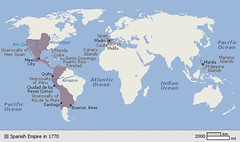Tuesday, October 20, 2009
From Mexico to Spain: follow the money
The Spanish Empire (Spanish: Imperio Español) was one of the largest empires in world history, and one of the first global empires, says Wikipedia.
It included territories and colonies in Europe, the Americas, Africa, Asia and Oceania, from the 15th century through—in the case of its African holdings—the latter portion of the 20th century.
Spain had emerged as a unified monarchy in 1492 following the reconquista (from the Moors, the Muslims who had controlled Spain for centuries) of the Iberian peninsula; that very year, Christopher Columbus commanded the first Spanish exploratory voyage across the Atlantic Ocean, leading to Europe's eventual colonial engagement with the Americas. The Western Hemisphere thereby became the focus of this new Spanish Empire.
During the Age of Discovery, Spain began to settle the Caribbean islands and conquistadors soon toppled native empires such as the Aztecs and Incas on mainland America.
Later expeditions established an empire that stretched from present-day Canada in North America to Tierra del Fuego in South America.
The Spanish expedition of world circumnavigation started by Ferdinand Magellan in 1519, and completed by Juan Sebastian Elcano in 1522, achieved what Columbus had longed for, a westward route to Asia, and brought the Far East to Spain's attention, where it established colonies in Guam, the Philippines and surrounding islands.
During its Siglo de Oro, the Spanish Empire comprised the Netherlands, Luxembourg, Belgium, most of Italy, parts of Germany, parts of France, territories in Africa, Asia and Oceania, as well as large areas in the Americas. By the 17th century Spain controlled an empire on a scale and world distribution that had never been approached by its predecessors[1].
In the 1520s the large scale extraction of silver from the rich deposits of Mexico's Guanajuato began, but it was not until the opening of the silver mines in Mexico's Zacatecas and Peru's Potosí in 1546 that the large shipments of silver became the fabled source of wealth.
During the sixteenth century, Spain held the equivalent of US$1.5 trillion (1990 terms) in gold and silver received from New Spain. Ultimately, however, these imports diverted investment away from other forms of industry and contributed to inflation in Spain in the last decades of the 16th century.
This situation was aggravated (though not as much as popular myth asserts) by the loss of much the commercial and artisan classes with the expulsions of the Jews and Moriscos. The vast imports of silver ultimately made Spain overly dependent on foreign sources of raw materials and manufactured goods.

